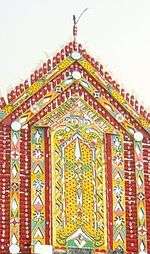Ngai
Ngai (other names: Engai, Enkai, Mweai or Mwiai) is the monolithic Supreme God in the spirituality of the Kamba and Kikuyu (or Gikuyu) of Kenya.[1] Ngai is creator of the universe and all in it. Regarded as the omnipotent God,[2] the Kikuyu worshiped Ngai facing the Mt. Kirinyaga (Mount Kenya) while prayers and goat sacrificial rituals were performed under the sacred Mugumo tree (a fig tree species). Occasions which may warrant sacrifice or libation include times of drought; epidemics; during planting and harvesting; and human life stages such as birth, marriage and death.[2][3]
| Part of a series on |
| Traditional African religions |
|---|
 |
|
Doctrines
|
|
Deities
|
|
Relation with other religions
|
|
Ngai was often referred to as "Mwene Nyaga" meaning (The Owner of the Dazzling Light). Kenyan anthropologist, later president, Jomo Kenyata notes that: "In prayers and sacrifices Ngai is addressed by the Gikuyu as Mwene-Nyaga (possessor of brightness)." He went on to write that: "This name is associated with Kĩrĩ-Nyaga (the Gikuyu name for Mount Kenya), which means: That which possesses brightness, or mountain of brightness."[4][5]
According to Kikuyu creation myth, Ngai created humanity, first man called Gikuyu and first woman called Mumbi. Ngai created a mountain "As his resting place when on inspection tour and as a sign of his wonders."[6] Gĩkũyũ and Mũmbi bore nine daughters who became the origins of 9 clans of Kikuyu people. "The names of the main clans are: (1) Acheera; (2) Agachikũ; (3) Airimũ; (4) Ambũi; (5) Angarĩ; (6) Anjirũ; (7) Angũi; (8) Ethaga; (9) Aithĩrandũ." [6]
References
- Kenyata (1938), pp. 22-23, 41, 233
- Middleton, John; Kershaw, Greet ; The Kikuyu and Kamba of Kenya: East Central Africa, Part 5, Routledge (reprint, 2017), p. 128, ISBN 9781315313115 (Retrieved 5 April 2019)
- Olney, James, Tell Me Africa: An Approach to African Literature, Princeton University Press (2015), p. 88, ISBN 9781400870592, Retrieved 5 April 2019)
- Kenyata, Jomo, Facing Mount Kenya, "The Conception of a Deity", (introduction by B. Malinowski) originally published by Martin Secker & Warburg LTD, (1938), [in] South African History Online, pp. 233-234 (PDF: pp. 261-262), (Retrieved 5 April 2019)
- Kenyata, Jomo, 'Facing Mount Kenya, (chapter: "The Conception of a Deity") [in] Ben-Jochannan, Yosef, African Origins of the Major "Western Religions", Black Classic Press (reprint, 1991), ISBN 9780933121294 pp. 42-49, (Retrieved 5 April 2019)
- Kenyatta, Jomo (1965). Facing Mt. Kenya (2nd ed.). Vintage Books. p. 175. ISBN 0-394-70210-7.CS1 maint: ref=harv (link)
Bibliography
- Kenyata, Jomo, Facing Mount Kenya, (introduction by B. Malinowski) originally published by Martin Secker & Warburg LTD, (1938), [in] South African History Online, pp. 22–23, 41, 233-234, (Retrieved 5 April 2019)
- Ben-Jochannan, Yosef, African Origins of the Major "Western Religions", Black Classic Press (reprint, 1991), pp. 42–49, ISBN 9780933121294 (Retrieved 5 April 2019)
- Middleton, John; Kershaw, Greet; The Kikuyu and Kamba of Kenya: East Central Africa, Part 5, Routledge (reprint, 2017), p. 128, ISBN 9781315313115 (Retrieved 5 April 2019)
- Kenyatta, Jomo (1965). Facing Mt. Kenya (2nd ed.). Vintage Books. p. 175
- Olney, James, Tell Me Africa: An Approach to African Literature, Princeton University Press (2015), p. 88, ISBN 9781400870592, Retrieved 5 April 2019)
Further reading
- J. N. van Luijk, Traditional Medicine Among the Kamba of Machakos District, Kenya, Volume 2, Royal Tropical Institute, Department of Tropical Hygiene, Sub. Department of Tropical Health (1982), Indiana University